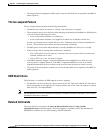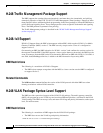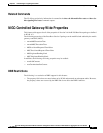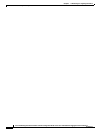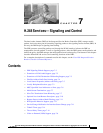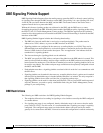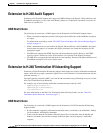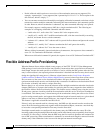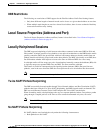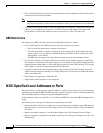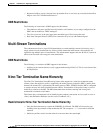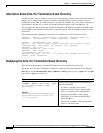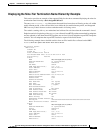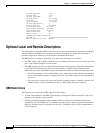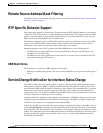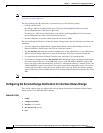
7-5
Cisco IOS XE Integrated Session Border Controller Configuration Guide for the Cisco ASR 1000 Series Aggregation Services Routers
OL-15421-01
Chapter 7 H.248 Services—Signaling and Control
Local Source Properties (Address and Port)
DBE Restrictions
The following are restrictions of DBE support for the Flexible Address Prefix Provisioning feature:
• Only three different lengths of network masks can be in use on a given shared address at one time.
• When multiple mask lengths are used on a shared local address, there is extra overhead of hash key
construction and flow entry lookup.
Local Source Properties (Address and Port)
The Local Source Properties (Address and Port) feature is described in the “Local Source Properties
(Address and Port)” section on page 8-4.
Locally Hairpinned Sessions
The DBE supports hairpinning of calls between subscribers connected to the same DBE for IPv4 and
IPv6 packets. A hairpin consists of two pinholes or two pairs of terminations on the DBE that the media
gateway controller (MGC) has provisioned with local and remote addresses whereby media from one
pinhole should travel directly (loops back) to the other pinhole. The MGC (also known as an SBE) does
not differentiate whether Add requests are sent to the same or different DBEs for a flow setup.
In a hairpin media call flow setup, two pairs of terminations internally connect the backbone (BB) side
to logically merge two separate DBEs into one DBE. The flow resembles a hairpin.
This feature is useful for interoperation with signaling border elements (SBEs) that provision two
pinholes, even in the case where the SBE does not require media to be sent further into the network.
Note Pinhole is an informal term for a pair of terminations in the same stream and same context.
Twice NAPT Pinhole Hairpinning
The DBE successfully forwards media through Twice Network Address and Port Translation (NAPT)
pinholes that form a hairpin. For Twice NAPT hairpinning, the DBE forwards media on demand. The
SBE sees no differences between Twice NAPT hairpins and Twice NAPT non-hairpins.
When forwarding media, a hairpin behaves the way two separate pinholes behave, except that a packet
going through a coupled pair has its IP Time-to-Live counter decremented only once, not twice.
Note Twice NAPT is only supported on IPv4.
No NAPT Pinhole Hairpinning
No NAPT pinholes can form hairpins only under the following circumstances:
• Both pinholes are No NAPT.



